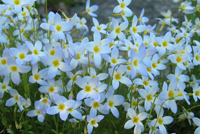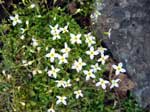
SCIENTIFIC NAME
Houstonia caerulea
DESCRIPTION
Bluets are low-growing perennials whose mound of leaves may reach one or two centimetres while the stalked flowers take the plant height up to 10 or 15 centimetres. There are numerous basal leaves and a few small opposite leaves along the stem. The tubular flowers have four petal-like lobes and appear singly atop a thin stem. They are blue with varying degrees of white, and have bright yellow centres.
RANGE
Bluets are native to southern Ontario, Quebec, New Brunswick and Nova Scotia.
HABITAT
Bluets are naturally found in wet grassy meadows, thickets, and open woods. Give them moist, slightly acidic soil (although they can tolerate drier conditions), and either full sun or partial shade. Bluets can be planted in a meadow or semi-shade garden, at the edge of a path or to replace lawn.
DIET
BEHAVIOUR
undefinedPRIMARY ECOSYSTEM ROLES
Bees and other insects visit this plant for nectar.


Bluets are native to southern Ontario, Quebec, New Brunswick and Nova Scotia (see below for other Canadian species) and can be planted in a meadow or semi-shade garden, at the edge of a path or to replace lawn. Bluets produce flowers on and off during the growing season, lighting up our woodland garden each spring en masse, and sporadically in the summer and fall, albeit in smaller numbers.
Bees and other insects visit this plant for nectar but there is little reference in the public record of use by humans, other than a possible remedy for bedwetting.
(Caution: We are not recommending the use of these plants for medicinal or food purposes. Many plants are poisonous or harmful if eaten or used externally. The information on food and medicinal value is only added for interest. It has been gathered from books and its accuracy has not been tested.)
 Propagation
Propagation
Bluets handle transplanting quite well, especially if you follow the basics of choosing a cool or cloudy day or evening for the job. Propagate by dividing or simply allow them to spread on their own, which they accomplish both by self-seeding and through underground rhizomes.
Care
Bluets are naturally found in wet grassy meadows, thickets, and open woods. Give them moist, slightly acidic soil (although they can tolerate drier conditions), and either full sun or partial shade.
Long-leaved bluet (Houstonia longifolia )
- Native to: southern Alberta, Saskatchewan, Manitoba, Ontario and southern Quebec.
- Habitat: typically found in gravelly areas; prefers sunny conditions but will tolerate partial shade and is very tolerant of dry soils.
- Appearance: about 20 centimetres tall. Small tubular flowers are similar to H. caerulea but are white or pale purple and form clusters at the ends of the stalks. Blooms in the summer months.
Canada bluet (Houstonia canadensis)
- Native to: southern Ontario
- Habitat: found in rocky or gravelly areas; takes full sun or partial shade
- Appearance: clusters of purple to white flowers bloom in the springtime and grow to15 centimetres. They are different to H. longifolia in that their petal-like lobes are more than half as long as the tubular part of the flower and they have basal leaves, fringed with fine hairs, by the time the flowers are in full bloom. In contrast, H. longifolia’s petal-like lobes are about half as long as the tubular part of the flower and the plant doesn’t usually have basal leaves when the flowers are in full bloom. When it does, both they and the stalk leaves do not have fringes.






